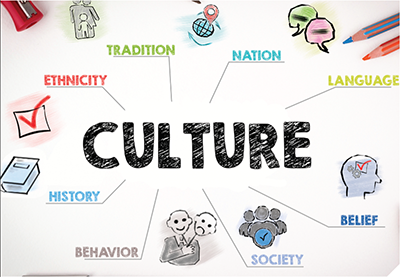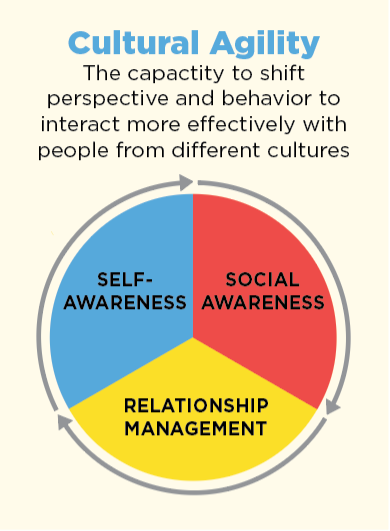Growing in Cultural Agility
By Sandra Harris Howard
 As a city leader, it is important for you to grow in cultural agility. You may be thinking, “What is that, why is it important, and how can I be intentional in developing cultural agility?”
As a city leader, it is important for you to grow in cultural agility. You may be thinking, “What is that, why is it important, and how can I be intentional in developing cultural agility?”
Cultural agility is a leadership skill that allows for more authentic community engagement. Higher levels of cultural agility will enable you to build a more equitable community and connect with the people you serve more deeply. This is more important than ever, as Minnesota cities are becoming increasingly diverse.
What is cultural agility?
Psychologist Paula Caligiuri, author of the book Build Your Cultural Agility, defines cultural agility as the ability to interact comfortably and effectively with people from other cultures.
Caligiuri says cultural agility causes us to seek out experiences that are multicultural and lead to a greater climate of inclusion. When “inclusion” is a core value of your city and its leaders, then you value the diversity of the people you serve.
The concept of “culture” — which is something we all have — is essential to understanding cultural agility. There are many ways to think about culture in our daily lives, and it is based on our values and experiences.
When we think of culture, we may think of things like language, food, attire, and customs. These are objective areas that we can see on the surface. Cultural markers like roles, myths, beliefs, expressions, and social expectations are subjective areas that are below the surface.
As we increase in cultural agility, we take the time to intentionally engage with and understand individuals and cultures that are different from our own. To increase our own cultural agility, we need to work on three areas: self-awareness, social awareness, and relationship management.
Self-awareness
First, we start by deepening our own self-awareness. This involves understanding our strengths and weaknesses and recognizing our dimensions of diversity. Our identities influence our perspectives, world views, and biases. When we have heightened self-awareness, we can better understand how our identities inform our interactions.
 Identities of gender, sexual orientation, race, ethnicity, spiritual/faith beliefs, age, physical abilities, and other characteristics are listed as part of the core dimensions of diversity developed in the 1990s by Mary Loden, co-author of Workforce America! Managing Employee Diversity as a Vital Resource.
Identities of gender, sexual orientation, race, ethnicity, spiritual/faith beliefs, age, physical abilities, and other characteristics are listed as part of the core dimensions of diversity developed in the 1990s by Mary Loden, co-author of Workforce America! Managing Employee Diversity as a Vital Resource.
There are other dimensions that come into play. They are income, marriage status, military status, family background, educational background, citizenship status, and parental status to name a few. As we become more self-aware, it is important to consider our own identities and the biases we hold toward other identities.
Jennifer Eberhart, author of the book Biased, says the brain creates and contributes to implicit bias. Our minds categorize what we see in the world to make sense of all the input we’re receiving.
“Our experiences in the world seep into our brain over time and, without our awareness, they conspire to reshape the working of our mind,” Eberhart says. We all have both explicit (conscious) and implicit (unconscious) biases. As we increase our cultural agility, we become more self-aware of our identities and our biases.
Social awareness
Next, we look at the critical component of social awareness. Our social awareness allows us to recognize commonalities and differences to best honor cultures and people we interact with.
This is broader than our own culture. It is the combination of knowledge and experience that enables us to recognize differences in the people and cultures around us. What are your identities and how can you be more aware of different demographics in your community?
Increasing cultural agility calls for moving toward greater social awareness of other cultures and identities. For example, when meeting people who are different from you, be curious and ask a question like: How can I find out more about your practice of observing Ramadan?
Relationship management
The third critical component of cultural agility is relationship management. It aligns with the first two components — self-awareness and social awareness. Relationships are key to strengthening our self-awareness and adapting our behaviors in our social awareness of others.
For most of us, relationship management takes a concerted effort. We typically spend time with people who are more like us than not. Even in situations where there is diversity of cultures and identities, we tend to lean into the commonalities because it is more comfortable. As the old saying goes, “Birds of a feather flock together.”
Relationships are formed around commonality, but they deepen when we recognize, acknowledge, and appreciate the differences. Relationship management allows the full person and perspectives of our identities to be seen.
Cultural agility increases with humility as we walk into diverse settings and realize that we may need to learn how to interact with a group.
When getting to know a community or person of another culture:
- Be authentic and true to who you are in your culture.
- Learn about the culture and be sensitive to differences.
For example, if you are interacting with someone from East Asia, be aware that maintaining eye contact is sometimes considered a sign of disrespect in their culture.
Next steps
To continue this journey of developing cultural agility, we should be willing to learn, listen, engage, and be accountable to create a transformed culture that is inclusive, thriving, and culturally agile. Here are a few tips:
- Learn. Own your own learning experiences. Read books, articles, and blogs from leaders that hold different dimensions of diversity or identities than you. Watch videos and movies that take deeper dives into our country’s history from a non-dominant culture perspective. Be willing to be uncomfortable as you learn new things that challenge your learned way of thinking.
- Listen. Listen to what is being said by the team members and leaders around you who hold marginalized identities or are underrepresented. Allow yourself to listen and not respond in a defensive way. Reflect on what is being shared. It requires empathy at a deep level to understand what is really being said and felt between the lines.
- Engage. Connect with people who you might not have had connections with in the past. Dr. Eric Mason, a pastor in Philadelphia, says, “Proximity breeds empathy, and distance breeds suspicion.” Look at the people you have lunch with, socialize with, or learn from. Are they like you in identities, or do they represent different identities and dimensions of diversity? This is where we have opportunities to grow and see the world through a different lens. When we don’t spend time with people who are different, we begin to live in a bubble and create an environment for implicit biases to grow.
- Be accountable for inclusive behaviors. Own your mistakes and look for ways to include voices that have been absent. This work is called an equity journey because it truly is a journey. As we change and create systems and practices that are equitable, we are going to make mistakes. When we fall into those moments of saying something offensive, it is our responsibility to be apologetic, be humble, receive guidance, and transform.
Let’s be intentional on our individual and collective journey of increasing our cultural agility. Our children, communities, and our world need the harmony that comes with more comfortably interacting with others that are not like us and treating them with respect, empathy, and humility. Remember, throughout this journey, we need to give each other grace.
Sandra Harris Howard, Ph.D., is senior director of equity and leadership development at the YMCA Equity Innovation Center.
Complete a free cultural agility competencies and cultural values assessment at www.mygiide.com.

